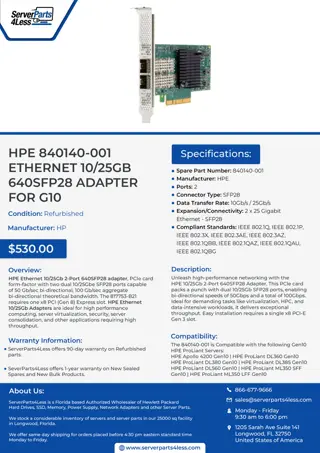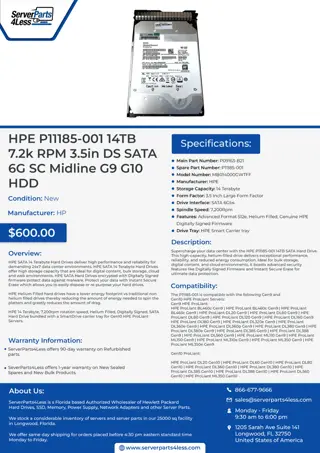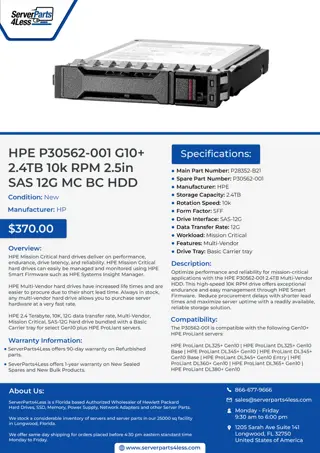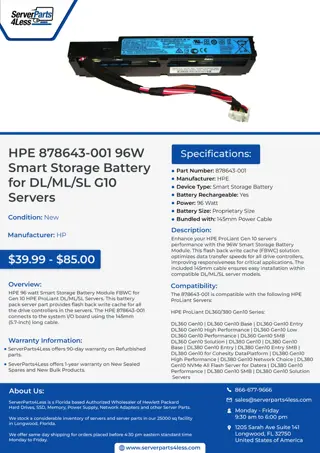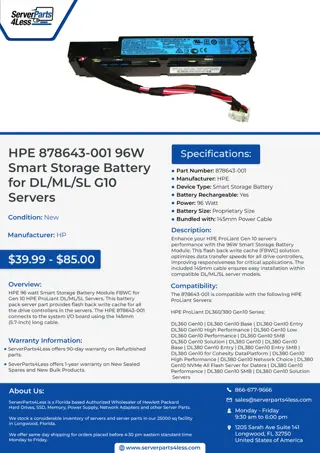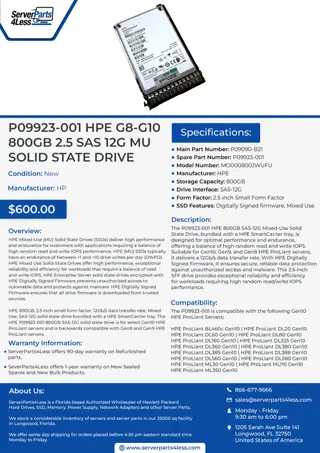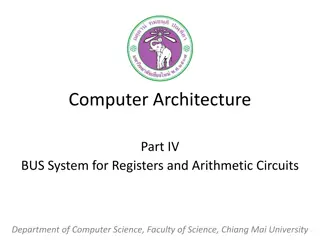
Choosing the Right Form of Business Ownership: A Comprehensive Guide
Learn about the different forms of business ownership, including sole proprietorship, and understand the advantages and disadvantages of each. Discover how choosing the correct form of ownership can impact the success and longevity of your business. Explore important concepts such as continuity, liability, and decision-making freedom to make informed decisions for your entrepreneurial journey.
Download Presentation

Please find below an Image/Link to download the presentation.
The content on the website is provided AS IS for your information and personal use only. It may not be sold, licensed, or shared on other websites without obtaining consent from the author. If you encounter any issues during the download, it is possible that the publisher has removed the file from their server.
You are allowed to download the files provided on this website for personal or commercial use, subject to the condition that they are used lawfully. All files are the property of their respective owners.
The content on the website is provided AS IS for your information and personal use only. It may not be sold, licensed, or shared on other websites without obtaining consent from the author.
E N D
Presentation Transcript
Forms of ownership Topic 9
Unit 1: Choosing a form of ownership The success of any business may depend on choosing the correct form of ownership These businesses range in size from a small spaza shop to a very big manufacturing business New Companies Act says no new close corporations can be registered
Unit 1: Choosing a form of ownership Lack of continuity when owner dies or is declared insolvent, the business ends Limited liability owner only liable for the amount invested in the business Unlimited liability owners are personally responsible for all the business debts. Personal assets may be used to pay off debts
Unit 2: The sole proprietor A sole trader owns and manages the business alone Known as OWNER Usually a small business, either trading business or service business Examples: plumbers, hairdressers, retail shops
Unit 2: The sole proprietor Characteristics: Simplest and oldest form of ownership Easy to establish, few legal formalities Lack of continuity Assets of the business belong to the owner
Unit 2: The sole proprietor Unlimited liability, owner liable for all debts All profits belong to owner Give notice for intention of closing business to protect creditors Can obtain capital from own capital or borrowed capital
Unit 2: The sole proprietor Advantages: Few legal formalities to start or end Owner personally involved Owner entitled to all profits Assets of business belong to owner Owner has freedom to make decisions Personal contact with customers
Unit 2: The sole proprietor Disadvantages: Owner dies, business ends Owner personally liable for all debts Personal assets may be sold for debts Owner responsible for capital Business may fail if owner does not have enough knowledge or experience
Unit 3: The partnership Two or more people enter into a contract to establish a new business Known as PARTNERS Usually in service industries Examples: accountants, lawyers, doctors
Unit 3: The partnership Characteristics: Minimum of 2 and maximum of 20 partners Unlimited liability, partners liable for debts Each partner taxed in personal capacity Formalities for establishment determined by a written partnership agreement. Aspects include:
Unit 3: The partnership Each partners contribution Name of business and full names of partners How profits and losses will be divided Procedure to end partnership Purpose is to make profit All partners must share in profits
Unit 3: The partnership There is lack of continuity if one partner dies or leaves or retires, a new partnership must be formed Common ways to end: partner dies or retires, new partner joins, business becomes insolvent Partners can obtain capital from own capital or borrowed capital
Unit 3: The partnership Advantages: Few legal requirements to establish or end More capital available than sole trader Each partner can specialise in different parts of the business More personal contact with customers
Unit 3: The partnership Disadvantages: Unlimited liability, all partners liable for debts Partners are jointly and severally liable Wrong actions of partners can influence business negatively Partners may disagree on how to run business New partnership to be formed when one member dies, retires or leaves
Unit 4: The close corporation No new close corporations can be formed since the new Companies Act Existing ones may continue to operate or can be sold as a shelf CC Known as: MEMBERS Suitable for small to medium size business
Unit 4: The close corporation Characteristics: Minimum of 1 member and maximum of 10 Name of business ends with CC It has unlimited existence (continuity) Members have an interest in CC, expressed as percentage
Unit 4: The close corporation Advantages: CC continues to exist even if change in membership Limited liability members will only lose money invested, not personal assets Easy and inexpensive to form a CC
Unit 4: The close corporation Disadvantages: Can no longer be registered in SA Maximum members is 10 which can be a problem if business wants to expand Less available capital Disagreements can lead to conflict
Unit 5: The profit company Aim is to make a profit by selling products or services Companies vary in size, turnover and the number of shareholders All companies need to comply with the terms of the Companies Act 71 of 2008
Unit 5: The profit company In terms of the Companies Act, the following are profit companies: Private company Public company Personal liability company Known as SHAREHOLDERS
Unit 5: The profit company Memorandum of Incorporation document required to register a new profit company It sets out the following: rights, responsibility and duties of shareholders, directors and others involved in the company Characteristics of the companies are as follows:
Unit 5: The profit company Private companies: Used to be limited to between 1 to 50 shareholders but now any number allowed Name ends with (Pty) Ltd Capital invested is divided into shares The articles of association limit the right to transfer shares
Unit 5: The profit company Permission of all shareholders needed before selling or giving shares to someone else Shares not freely sold to the public Minority shareholders are able to call a general meeting Examples of private companies: Adcock Ingram Healthcare, Adidas, Woolworths
Unit 5: The profit company Public companies: Usually very large businesses eg. SAB Name ends with Ltd Any member of the public can buy shares Used to have minimum of 7 shareholders but now the minimum is 1
Unit 5: The profit company Maximum number of shareholders is determined by the issued share capital Acquire capital by issuing shares to the public (issuing a prospectus) Shares can be sold or given to another person without restrictions Examples: Absa Bank, African Bank, Tiger Brands
Unit 5: The profit company Personal liability companies: Must meet criteria for private company and its Memorandum of Incorporation should clearly state it s a personal liability company Name ends with Inc Usually associations of professionals eg. Lawyers, accountants, attorneys
Unit 5: The profit company Advantages for all companies: They have limited liability only lose the money invested in shares Has unlimited lifetime death or retirement of a shareholder does not terminate company Greater access to financial resources so it s easy to raise capital
Unit 5: The profit company Appoint skilled and knowledgeable managers Business rescue scheme if struggling financially, creditors need to wait for company to be fully operational again Shareholder participation has changed. Allowed to participate outside of meetings
Unit 5: The profit company Disadvantages for all companies: Comply with many legal requirements Tax burden is more than other forms of ownership Board of directors could be less personally involved in management High costs involved eg. Establishment fees
Unit 5: The profit company Little personal contact between shareholders and customers A director may be liable for losses if they make an unlawful decision Private companies cannot freely sell shares, must offer to existing shareholders first Transfer of shares restricted in private companies
Unit 5: The profit company State-owned profit companies owned by state and managed by the government Name ends with SOC Ltd State can create products or services believed to be of economic and political importance to the country
Unit 5: The profit company Services such as electricity, rail transport and hospitals are set up and managed by the government, using tax money Local government - refuse removal, sewage, public swimming pools and libraries are funded by rates and taxes paid by locals Examples: Eskom, SABC, Transnet
Unit 5: The profit company Advantages: Essential services provided Everyone shares in the profit from public ownership Wasteful duplication of services is eliminated Planning can be co-ordinated through central control
Unit 5: The profit company Disadvantages: Inefficiency results due to size of organisation Lack of incentive for employees to perform if not given a share in the profits Losses met by the taxpayer Political interference can occur Interfere with free market forces Difficult to find someone to deal with complaints
Unit 6: The non-profit company Registered to provide a service and do not intend to make a profit Often funded by donations and foreign funding Examples: Meals on Wheels, SPCA, South African Guide-Dogs and Aids orphans organisations
Unit 6: The non-profit company Characteristics: No minimum or maximum members, used to be minimum of 7 members and 2 directors Name ends with NPC All profits made is used for primary objective Obtain funds from outside sources
Unit 6: The non-profit company Advantages: Profits used for primary objective Provide services to various communities People who make donations receive tax deductions Limited liability organisation responsible Has continuity
Unit 6: The non-profit company Disadvantages: Difficult to set up and need professional assistance Need lawyer services for documentation Income not enough to cover expenses Rely on donations from the public Not allowed to pay bonuses to members On closing, assets given to similar NPC
Unit 7: The co-operative Business is owned and run by its members Objective is the mutual benefit of the group Share equally in the profits Decisions are taken democratically Managed by minimum of 3 directors Popular in agriculture industry
Unit 7: The co-operative Characteristics: Register with Registrar of Co-operative Societies Name must have Co- Operative Ltd Limited liability Members to act in good faith and have a say in the running and control of co-op
Unit 7: The co-operative Advantages: Liability of members is limited Unlimited continuity Members may receive greater advantages than expected Manages according to requirements in the Co-operatives Act, which limits management
Unit 7: The co-operative Disadvantages: Funds are limited Success depends on support of the members May lack experienced and skilled business leaders Shares are not freely transferable






